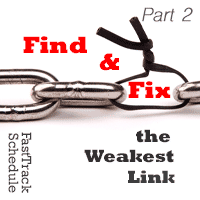 We all hit the wall at some point. Projects go awry, issues mount and we need to take action. The pressure mounts and tests our ability to make good sound decisions for our projects and for our project customers. What’s your point? At what point do you feel like you might be ready to pull all of your hair out and literally lose control? We all – at some time or another – reach that point where we just can’t take it anymore. And what it is depends on us. It may be too much distraction. It may be too much interruption. It may be too much stupidness (you’re resisting the very real temptation to slap someone upside the head – you know what I mean). Or it may be too much pressure. How we handle hitting that breaking point may say a lot about who we are and it may have a big impact on how we’re managing our projects and it may even have a big impact on our careers if the stressor or issue is big enough.
We all hit the wall at some point. Projects go awry, issues mount and we need to take action. The pressure mounts and tests our ability to make good sound decisions for our projects and for our project customers. What’s your point? At what point do you feel like you might be ready to pull all of your hair out and literally lose control? We all – at some time or another – reach that point where we just can’t take it anymore. And what it is depends on us. It may be too much distraction. It may be too much interruption. It may be too much stupidness (you’re resisting the very real temptation to slap someone upside the head – you know what I mean). Or it may be too much pressure. How we handle hitting that breaking point may say a lot about who we are and it may have a big impact on how we’re managing our projects and it may even have a big impact on our careers if the stressor or issue is big enough.
In our line of work – as the PM of the engagement – it is critical that we actually stay in charge and maintain the perception of remaining in control. Especially in stressful or critical situations. If the customer senses that we’re losing control of our team, or the project, or the situation as a whole, then they are going to become frustrated and uncomfortable. And, at that point of discomfort, they will certainly question our leadership. They should. That’s why we must remain in control. But how? When the walls are caving in, how do we remain calm? How do we maintain balance and control? Fake it? For me it comes down to three main concepts or steps: Avoiding taking too drastic of an action that you might regret, over communicate, stick to best practices, and document everything. Let’s examine each of these…
Don’t take too drastic of an action
Avoid taking unnecessary risks during times like this – you will probably live to regret it. Sometimes, when we are stressed or under great pressure, we may have a tendency to divert from our normal routine or normal decision-making and take certain risks that we would not otherwise take. Please avoid this at all costs. Seriously, unless the project calls for some drastic measures, don’t go crazy. Taking unnecessary risks or drastic measures can kill the project budget, cause concern among team members and the customer and usually is somewhat detrimental to the forward progress of the project.
Communicate, communicate, communicate
During times of critical issues on the project, when things seem stressful, you may have a tendency to huddle frequently with the project team. Do not leave the customer out in the cold. Over communicate, don’t under communicate. The customer needs to know what’s going on. A customer who is out of the loop will feel like you’re not telling them everything, they’ll think you’re being deceitful, they’ll become frustrated, and they’ll likely be on the phone with your CEO – which is not good.
Stick to the basics
Remember, best practices is usually your best bet. Never abandon the basics. Even if you feel you have to take some drastic measures in contradiction to my point above, you must still stick to the project basics and best practices. Continue with the regular status meetings, keep producing the project status report and delivering it with pinpoint regularity. Stay up on the project schedule and keep your team and customer up on the project schedule. This is particularly important during problematic times on the project so that you don’t add to customer frustration and dissatisfaction.
Document everything
Just as this is not the time to decrease communication it is also not the time to skimp on documentation on the project. When we are running in emergency mode sometimes we think the fundamentals can take a backseat and everything will be ok. I say that this is exactly the time that we need to document everything. When there are problems on the project, if the worst case scenarios become a reality and you end up being – heaven forbid – sued by your client, having the proper documentation in place showing due diligence on the project will definitely work in your favor. And even if we’re not talking about a situation that dire, it’s still best in the name of good project management and good customer relations to continue to provide and produce appropriate documentation for deliverables and status situations on the engagement.
Summary
The bottom line is this – act and act quickly. But also act wisely. What you do doesn’t really change – but you may need to over emphasize, become hyper vigilant.
What about our readers – how do you react to extreme pressure on your projects? What happens when your project is in duress and you need to turn it up a notch? Let’s discuss.



